初中英语八种时态归纳复习
英语八大时态整理归纳
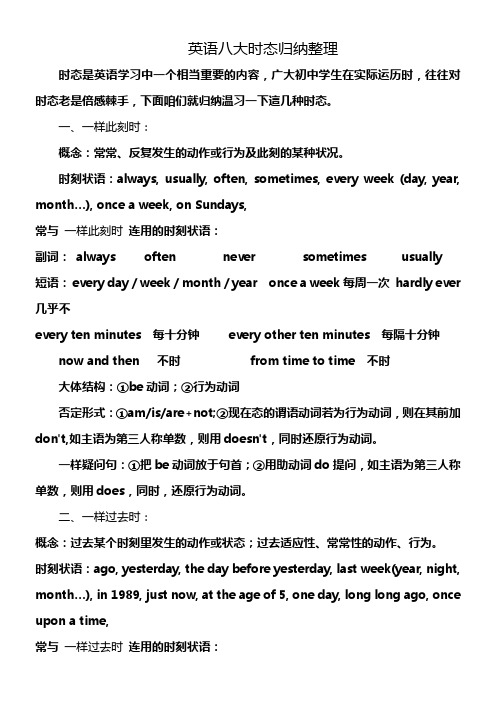
英语八大时态归纳整理时态是英语学习中一个相当重要的内容,广大初中学生在实际运历时,往往对时态老是倍感棘手,下面咱们就归纳温习一下這几种时态。
一、一样此刻时:概念:常常、反复发生的动作或行为及此刻的某种状况。
时刻状语:always, usually, often, sometimes, every week (day, year, month…), once a week, on Sundays,常与一样此刻时连用的时刻状语:副词:always often never sometimes usually短语:every day / week / month / year once a week每周一次hardly ever 几乎不every ten minutes 每十分钟every other ten minutes 每隔十分钟now and then 不时from time to time 不时大体结构:①be动词;②行为动词否定形式:①am/is/are+not;②现在态的谓语动词若为行为动词,则在其前加don't,如主语为第三人称单数,则用doesn't,同时还原行为动词。
一样疑问句:①把be动词放于句首;②用助动词do提问,如主语为第三人称单数,则用does,同时,还原行为动词。
二、一样过去时:概念:过去某个时刻里发生的动作或状态;过去适应性、常常性的动作、行为。
时刻状语:ago, yesterday, the day before yesterday, last week(year, night, month…), in 1989, just now, at the a ge of 5, one day, long long ago, once upon a time,常与一样过去时连用的时刻状语:1、副词:yesterday2、短语:last week / month / year / night last Monday lastMayyesterday morning / afternoon / evening two days ago the other day 头几天just now = a moment ago the day before yesterdayin (已过去的)某年/ 月on (已过去的)某天at (已过去的)几点钟大体结构:①be动词;②行为动词否定形式:①was/were+not;②在行为动词前加didn't,同时还原行为动词。
初中英语八种时态归纳复习 详解
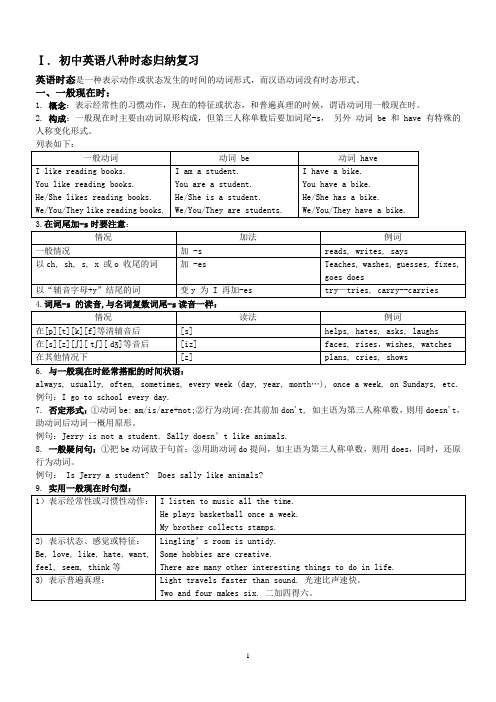
Ⅰ. 初中英语八种时态归纳复习英语时态是一种表示动作或状态发生的时间的动词形式,而汉语动词没有时态形式。
一、一般现在时:1. 概念:表示经常性的习惯动作,现在的特征或状态,和普遍真理的时候,谓语动词用一般现在时。
2. 构成:一般现在时主要由动词原形构成,但第三人称单数后要加词尾-s,另外动词be 和 have 有特殊的人称变化形式。
6. 与一般现在时经常搭配的时间状语:always, usually, often, sometimes, every week (day, year, month…), once a week, on Sundays, etc.例句:I go to school every day.7. 否定形式:①动词be: am/is/are+not;②行为动词:在其前加don't, 如主语为第三人称单数,则用doesn't,助动词后动词一概用原形。
例句:Jerry is not a student. Sally doesn’t like animals.8. 一般疑问句:①把be动词放于句首;②用助动词do提问,如主语为第三人称单数,则用does,同时,还原行为动词。
例句: Is Jerry a student? Does sally like animals?9. 实用一般现在时句型:二、一般过去时1.概念:过去某个时间里发生的动作或状态,现在已经不再继续;过去习惯性、经常性的动作、行为。
2.构成:一般过去时由动词的过去式表示,1) 动词be有 was, were 两个过去式,was 用于第一、第三人称, were 用于第二人称和第一、二、三人称的复数形式。
动词表。
读音规则:month…), in 1989, just now, at the age of 5, one day, long long ago, once upon a time, etc.4.否定形式:①was/were+not;②在行为动词前加助动词didn't,助动词后加动词原形。
(完整版)初中英语八种时态总结归纳
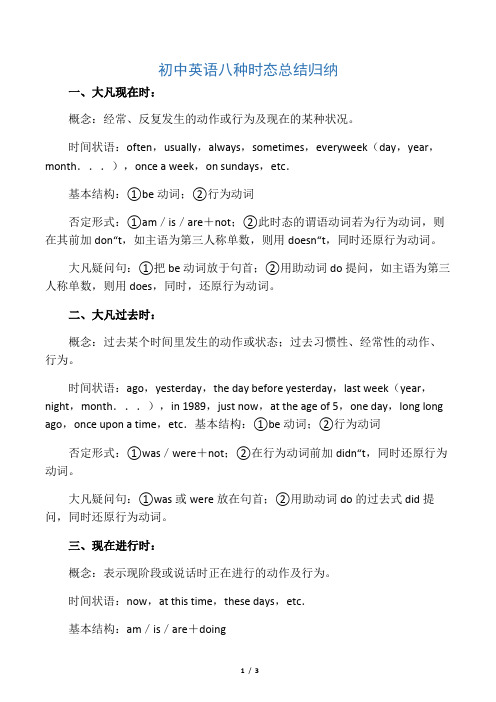
初中英语八种时态总结归纳一、大凡现在时:概念:经常、反复发生的动作或行为及现在的某种状况。
时间状语:often,usually,always,sometimes,everyweek(day,year,month...),once a week,on sundays,etc.基本结构:①be动词;②行为动词否定形式:①am/is/are+not;②此时态的谓语动词若为行为动词,则在其前加don“t,如主语为第三人称单数,则用doesn“t,同时还原行为动词。
大凡疑问句:①把be动词放于句首;②用助动词do提问,如主语为第三人称单数,则用does,同时,还原行为动词。
二、大凡过去时:概念:过去某个时间里发生的动作或状态;过去习惯性、经常性的动作、行为。
时间状语:ago,yesterday,the day before yesterday,last week(year,night,month...),in 1989,just now,at the age of 5,one day,long long ago,once upon a time,etc.基本结构:①be动词;②行为动词否定形式:①was/were+not;②在行为动词前加didn“t,同时还原行为动词。
大凡疑问句:①was或were放在句首;②用助动词do的过去式did提问,同时还原行为动词。
三、现在进行时:概念:表示现阶段或说话时正在进行的动作及行为。
时间状语:now,at this time,these days,etc.基本结构:am/is/are+doing否定形式:am/is/are+not+doing大凡疑问句:把be动词放在句首四、过去进行时:概念:表示过去某段时间或某一时刻正在发生或进行的行为或动作。
时间状语:at this time yesterday,at that time或以when引导的谓语动词是大凡过去时的时间状语等。
初中英语八种时态总结归纳
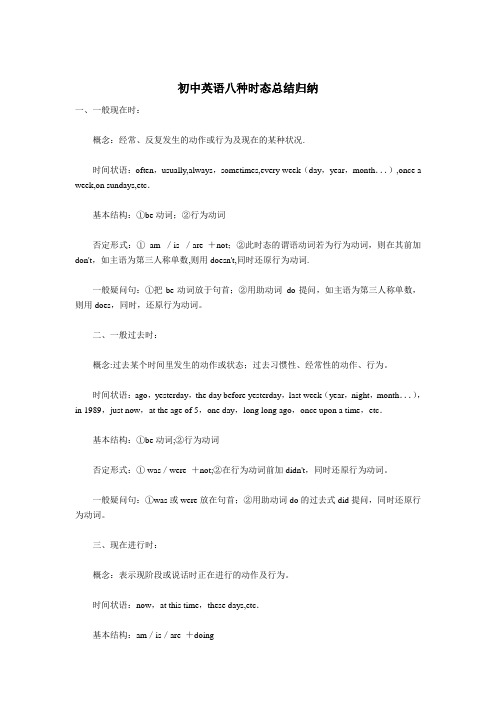
初中英语八种时态总结归纳一、一般现在时:概念:经常、反复发生的动作或行为及现在的某种状况.时间状语:often,usually,always,sometimes,every week(day,year,month...),once a week,on sundays,etc.基本结构:①be动词;②行为动词否定形式:①am /is /are +not;②此时态的谓语动词若为行为动词,则在其前加don't,如主语为第三人称单数,则用doesn't,同时还原行为动词.一般疑问句:①把be动词放于句首;②用助动词do提问,如主语为第三人称单数,则用does,同时,还原行为动词。
二、一般过去时:概念:过去某个时间里发生的动作或状态;过去习惯性、经常性的动作、行为。
时间状语:ago,yesterday,the day before yesterday,last week(year,night,month...),in 1989,just now,at the age of 5,one day,long long ago,once upon a time,etc.基本结构:①be动词;②行为动词否定形式:① was/were +not;②在行为动词前加didn't,同时还原行为动词。
一般疑问句:①was或were放在句首;②用助动词do的过去式did提问,同时还原行为动词。
三、现在进行时:概念:表示现阶段或说话时正在进行的动作及行为。
时间状语:now,at this time,these days,etc.基本结构:am/is/are +doing否定形式:am/is/are +not+doing一般疑问句:把be动词放在句首四、过去进行时:概念:表示过去某段时间或某一时刻正在发生或进行的行为或动作。
时间状语:at this time yesterday,at that time或以when引导的谓语动词是一般过去时的时间状语等。
初中英语语法八大时态总结(完整版)
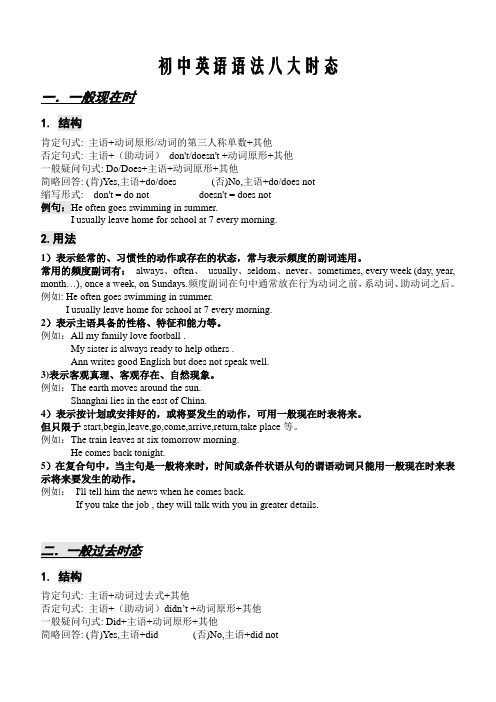
— I'm going to go fishing.
— Where is the telephone book?
— I'll go and get it for you.
两者都用于预测时,be going to意指有迹象表明某件事将要发生,属客观的推测;will则意指说话人认为/相信某件事将要发生,属主观的推测。
2)、表示说话人对于将来的看法、假设和推测,通常用于be afraid, be/feel sure, hope, know, think等后面的从句或与副词perhaps,possibly,maybe等连用。
例如:I think she’ll go back home for supper.
Maybe she’ll go to the gym.
认知类
Believe,think,understand,forget,remember
存在类
Appear,exist,lie,remain
占有、从属类
Have,own,contain,belong,possess,consist of
短暂动作类
Accept,receive,admit,decide,promise,give,finish
2)“beto+动词原形”表示客观安排或受人指示而将要做某事。
例如:We are to discuss the report next Saturday.
3)be about to +动词原形,意为马上做某事。不能与tomorrow, next week等表示明确将来时的时间状语连用,多于when引导的时间状语连用。
初中英语的八种时态

Ⅰ. 初中英语八种时态归纳复习时态是英语学习中一个至关重要的内容,广大初中学生在实际运用时,往往对时态总是倍感棘手,下面我们就归纳复习一下這几种时态。
一、一般现在时:概念:经常、反复发生的动作或行为及现在的某种状况。
时间状语:always, usually, often, sometimes, every week (day, year, month…), once a week, on Sundays, etc.基本结构:①be动词;②行为动词否定形式:①am/is/are+not;②此时态的谓语动词若为行为动词,则在其前加don't,如主语为第三人称单数,则用doesn't,同时还原行为动词。
一般疑问句:①把be动词放于句首;②用助动词do提问,如主语为第三人称单数,则用does,同时,还原行为动词。
二、一般过去时:概念:过去某个时间里发生的动作或状态;过去习惯性、经常性的动作、行为。
时间状语:ago, yesterday, the day before yesterday, last week(year, night, month…), in 1989, just now, at the age of 5, one day, long long ago, once upon a time, etc.基本结构:①be动词;②行为动词否定形式:①was/were+not;②在行为动词前加didn't,同时还原行为动词。
一般疑问句:①was或were放于句首;②用助动词do的过去式did 提问,同时还原行为动词。
三、现在进行时:概念:表示现阶段或说话时正在进行的动作及行为。
时间状语:now, at this time, these days, etc.基本结构:am/is/are+doing否定形式:am/is/are+not+doing.一般疑问句:把be动词放于句首。
初中英语八种时态归纳复习要点

初中英语八种时态归纳复习要点always, usually, often, sometimes, every week (day, year, month), once a week, on Sundays, etc.基本结构:①be动词;②行为动词否定形式:①am/is/are+not;②此时态的谓语动词若为行为动词,则在其前加dont,如主语为第三人称单数,则用doesnt,同时还原行为动词。
一般疑问句:①把be动词放于句首;②用助动词do提问,如主语为第三人称单数,则用does,同时,还原行为动词。
初中英语语法时态二、一般过去时概念:过去某个时间里发生的动作或状态;过去习惯性、经常性的动作、行为。
时间状语:ago, yesterday, the day before yesterday, last week(year, night, month), in 1989, just now, at the age of 5, one day, long long ago, once upon a time, etc.基本结构:①be动词;②行为动词否定形式:①was/were+not;②在行为动词前加didnt,同时还原行为动词。
一般疑问句:①was或were放于句首;②用助动词do的过去式did 提问,同时还原行为动词。
初中英语语法时态三、现在进行时概念:表示现阶段或说话时正在进行的动作及行为。
时间状语:now, at this time, these days, etc.基本结构:am/is/are+doing否定形式:am/is/are+not+doing.一般疑问句:把be动词放于句首。
初中英语语法时态四、过去进行时概念:表示过去某段时间或某一时刻正在发生或进行的行为或动作。
时间状语:at this time yesterday, at that time或以when引导的谓语动词是一般过去时的时间状语等。
初中英语八种时态归纳
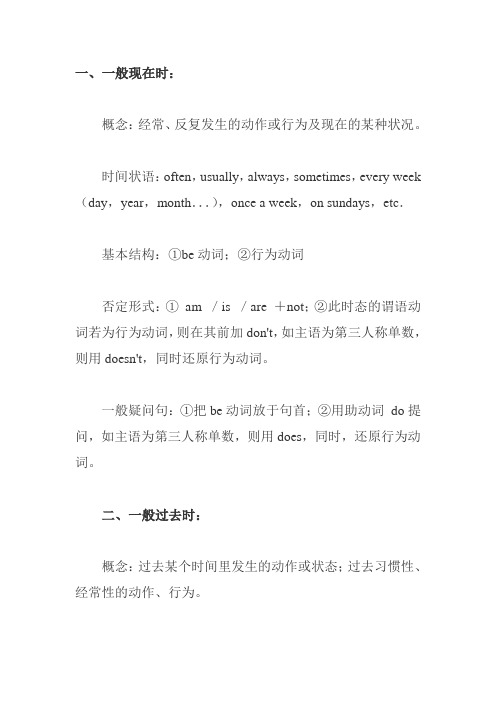
一、一般现在时:概念:经常、反复发生的动作或行为及现在的某种状况。
时间状语:often,usually,always,sometimes,every week (day,year,month...),once a week,on sundays,etc.基本结构:①be动词;②行为动词否定形式:①am /is /are +not;②此时态的谓语动词若为行为动词,则在其前加don't,如主语为第三人称单数,则用doesn't,同时还原行为动词。
一般疑问句:①把be动词放于句首;②用助动词do提问,如主语为第三人称单数,则用does,同时,还原行为动词。
二、一般过去时:概念:过去某个时间里发生的动作或状态;过去习惯性、经常性的动作、行为。
时间状语:ago,yesterday,the day before yesterday,last week(year,night,month...),in 1989,just now,at the age of 5,one day,long long ago,once upon a time,etc.基本结构:①be动词;②行为动词否定形式:①was/were +not;②在行为动词前加didn't,同时还原行为动词。
一般疑问句:①was或were放在句首;②用助动词do 的过去式did提问,同时还原行为动词。
三、现在进行时:概念:表示现阶段或说话时正在进行的动作及行为。
时间状语:now,at this time,these days,etc.基本结构:am/is/are +doing否定形式:am/is/are +not+doing一般疑问句:把be动词放在句首四、过去进行时:概念:表示过去某段时间或某一时刻正在发生或进行的行为或动作。
时间状语:at this time yesterday,at that time或以when 引导的谓语动词是一般过去时的时间状语等。
中考英语必考的八种时态知识汇总
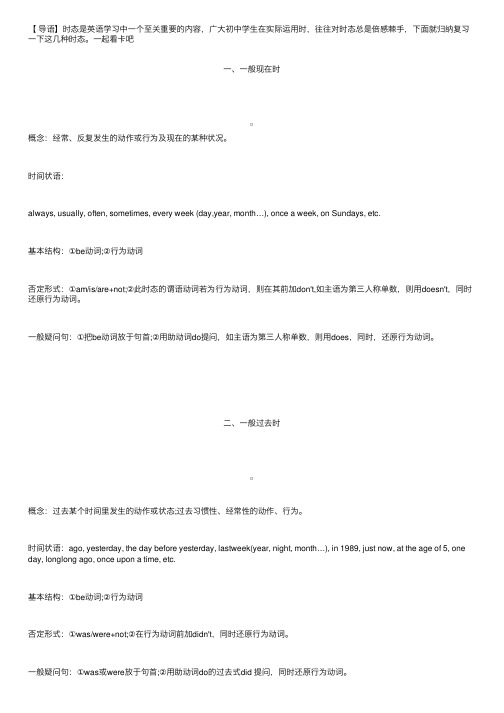
【导语】时态是英语学习中⼀个⾄关重要的内容,⼴⼤初中学⽣在实际运⽤时,往往对时态总是倍感棘⼿,下⾯就归纳复习⼀下这⼏种时态。
⼀起看卡吧⼀、⼀般现在时概念:经常、反复发⽣的动作或⾏为及现在的某种状况。
时间状语:always, usually, often, sometimes, every week (day,year, month…), once a week, on Sundays, etc.基本结构:①be动词;②⾏为动词否定形式:①am/is/are+not;②此时态的谓语动词若为⾏为动词,则在其前加don't,如主语为第三⼈称单数,则⽤doesn't,同时还原⾏为动词。
⼀般疑问句:①把be动词放于句⾸;②⽤助动词do提问,如主语为第三⼈称单数,则⽤does,同时,还原⾏为动词。
⼆、⼀般过去时概念:过去某个时间⾥发⽣的动作或状态;过去习惯性、经常性的动作、⾏为。
时间状语:ago, yesterday, the day before yesterday, lastweek(year, night, month…), in 1989, just now, at the age of 5, one day, longlong ago, once upon a time, etc.基本结构:①be动词;②⾏为动词否定形式:①was/were+not;②在⾏为动词前加didn't,同时还原⾏为动词。
⼀般疑问句:①was或were放于句⾸;②⽤助动词do的过去式did 提问,同时还原⾏为动词。
三、现在进⾏时概念:表⽰现阶段或说话时正在进⾏的动作及⾏为。
时间状语:now, at this time, these days, etc.基本结构:am/is/are+doing否定形式:am/is/are+not+doing.⼀般疑问句:把be动词放于句⾸。
四、过去进⾏时概念:表⽰过去某段时间或某⼀时刻正在发⽣或进⾏的⾏为或动作。
初中英语八种时态总结归纳

初中英语八种时态总结归纳般现在时:概念:经常、反复发生的动作或行为及现在的某种状况。
时间状语:ofte n,usually,always,sometimes,every week ( day, year,month ...), once a week, on sun days, etc.基本结构:①be动词;②行为动词否定形式:① am /is /are + not;②此时态的谓语动词若为行为动词,则在其前加don't,如主语为第三人称单数,则用does n't,同时还原行为动词。
一般疑问句:①把be动词放于句首;②用助动词do提问,如主语为第三人称单数,则用does,同时,还原行为动词。
二、一般过去时:概念:过去某个时间里发生的动作或状态;过去习惯性、经常性的动作、行为。
时间状语:ago,yesterday,the day before yesterday,last week (year,night,month...),in 1989,just now,at the age of 5,one day, long long ago,once upon a time,etc.基本结构:①be动词;②行为动词否定形式:①was/were + not;②在行为动词前加did n't,同时还原行为动词。
一般疑问句:①was或were放在句首;②用助动词do的过去式did提问,同时还原行为动词。
三、现在进行时:概念:表示现阶段或说话时正在进行的动作及行为。
时间状语:now , at this time, these days, etc.基本结构:am/is/ are + doing否定形式:am/is/ are + not+doing一般疑问句:把be动词放在句首四、过去进行时:概念:表示过去某段时间或某一时刻正在发生或进行的行为或动作。
时间状语:at this time yesterday,at that time或以when引导的谓语动词是一般过去时的时间状语等。
初中英语时态8种基本时态归纳
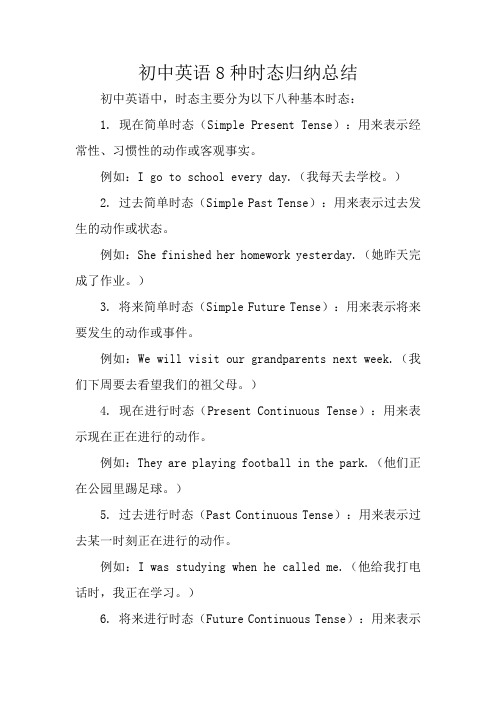
初中英语8种时态归纳总结初中英语中,时态主要分为以下八种基本时态:1. 现在简单时态(Simple Present Tense):用来表示经常性、习惯性的动作或客观事实。
例如:I go to school every day.(我每天去学校。
)2. 过去简单时态(Simple Past Tense):用来表示过去发生的动作或状态。
例如:She finished her homework yesterday.(她昨天完成了作业。
)3. 将来简单时态(Simple Future Tense):用来表示将来要发生的动作或事件。
例如:We will visit our grandparents next week.(我们下周要去看望我们的祖父母。
)4. 现在进行时态(Present Continuous Tense):用来表示现在正在进行的动作。
例如:They are playing football in the park.(他们正在公园里踢足球。
)5. 过去进行时态(Past Continuous Tense):用来表示过去某一时刻正在进行的动作。
例如:I was studying when he called me.(他给我打电话时,我正在学习。
)6. 将来进行时态(Future Continuous Tense):用来表示将来某一时刻正在进行的动作。
例如:She will be working on her project tomorrow.(明天她会一直在做她的项目。
)7. 现在完成时态(Present Perfect Tense):用来表示过去发生的动作对现在产生的影响或结果。
例如:I have finished my homework.(我已经完成了我的作业。
)8. 过去完成时态(Past Perfect Tense):用来表示过去某个时间点之前已经完成的动作。
例如:They had already left when we arrived.(当我们到达时,他们已经离开了。
初中英语的八种时态

Ⅰ. 初中英语八种时态归纳复习时态是英语学习中一个至关重要的内容,广大初中学生在实际运用时,往往对时态总是倍感棘手,下面我们就归纳复习一下這几种时态。
一、一般现在时:概念:经常、反复发生的动作或行为及现在的某种状况。
时间状语:always, usually, often, sometimes, every week (day, year, month…), once a week, on Sundays, etc.基本结构:①be动词;②行为动词否定形式:①am/is/are+not;②此时态的谓语动词若为行为动词,则在其前加don't,如主语为第三人称单数,则用doesn't,同时还原行为动词。
一般疑问句:①把be动词放于句首;②用助动词do提问,如主语为第三人称单数,则用does,同时,还原行为动词。
二、一般过去时:概念:过去某个时间里发生的动作或状态;过去习惯性、经常性的动作、行为。
时间状语:ago, yesterday, the day before yesterday, last week(year, night, month…), in 1989, just now, at the age of 5, one day, long long ago, once upon a time, etc. 基本结构:①be动词;②行为动词否定形式:①was/were+not;②在行为动词前加didn't,同时还原行为动词。
一般疑问句:①was或were放于句首;②用助动词do的过去式did 提问,同时还原行为动词。
三、现在进行时:概念:表示现阶段或说话时正在进行的动作及行为。
时间状语:now, at this time, these days, etc.基本结构:am/is/are+doing否定形式:am/is/are+not+doing.一般疑问句:把be动词放于句首。
初中英语八种时态归纳
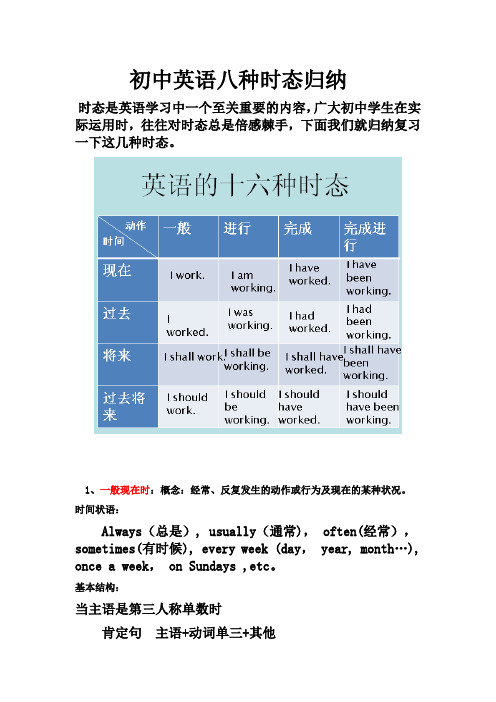
初中英语八种时态归纳时态是英语学习中一个至关重要的内容,广大初中学生在实际运用时,往往对时态总是倍感棘手,下面我们就归纳复习一下这几种时态。
1、一般现在时:概念:经常、反复发生的动作或行为及现在的某种状况。
时间状语:Always(总是), usually(通常), often(经常),sometimes(有时候), every week (day, year, month…), once a week, on Sundays ,etc。
基本结构:当主语是第三人称单数时肯定句主语+动词单三+其他否定句主语+doesn't+动词原形+其他一般疑问句 Does+主语+动词原形+其他肯定回答 Yes,主语+does否定回答 No,主语+doesn’t当主语不是第三人称单数时肯定句主语+动词原形+其他否定句主语+don’t+动词原形+其他一般疑问句 Do+主语+动词原形+其他例句:I never get up early on Sundays.特殊疑问句特殊疑问词(when,where,who,how ,etc.)+一般疑问句2、一般过去时:概念:过去某个时间里发生的动作或状态;过去习惯性、经常性的动作、行为.时间状语:ago, yesterday, the day before yesterday, last week(year,night, month…), in 1989, just now, at the age of 5, one day, long long ago, once upon a time, etc。
基本结构:主语+动词过去式+其他否定形式did+not+do+其他;一般疑问句did+主语+do+其他?例句:I went to Italy 。
I visited museums and sat in public gardens3、现在进行时:概念:表示现阶段或说话时正在进行的动作及行为。
初中英语的八种时态
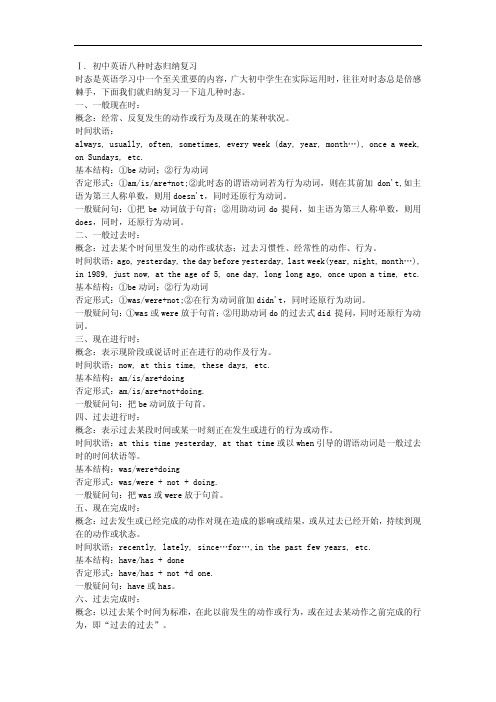
Ⅰ. 初中英语八种时态归纳复习时态是英语学习中一个至关重要的内容,广大初中学生在实际运用时,往往对时态总是倍感棘手,下面我们就归纳复习一下這几种时态。
一、一般现在时:概念:经常、反复发生的动作或行为及现在的某种状况。
时间状语:always, usually, often, sometimes, every week (day, year, month…), once a week, on Sundays, etc.基本结构:①be动词;②行为动词否定形式:①am/is/are+not;②此时态的谓语动词若为行为动词,则在其前加don't,如主语为第三人称单数,则用doesn't,同时还原行为动词。
一般疑问句:①把be动词放于句首;②用助动词do提问,如主语为第三人称单数,则用does,同时,还原行为动词。
二、一般过去时:概念:过去某个时间里发生的动作或状态;过去习惯性、经常性的动作、行为。
时间状语:ago, yesterday, the day before yesterday, last week(year, night, month…), in 1989, just now, at the age of 5, one day, long long ago, once upon a time, etc. 基本结构:①be动词;②行为动词否定形式:①was/were+not;②在行为动词前加didn't,同时还原行为动词。
一般疑问句:①was或were放于句首;②用助动词do的过去式did 提问,同时还原行为动词。
三、现在进行时:概念:表示现阶段或说话时正在进行的动作及行为。
时间状语:now, at this time, these days, etc.基本结构:am/is/are+doing否定形式:am/is/are+not+doing.一般疑问句:把be动词放于句首。
初中英语语法动词八种时态详解
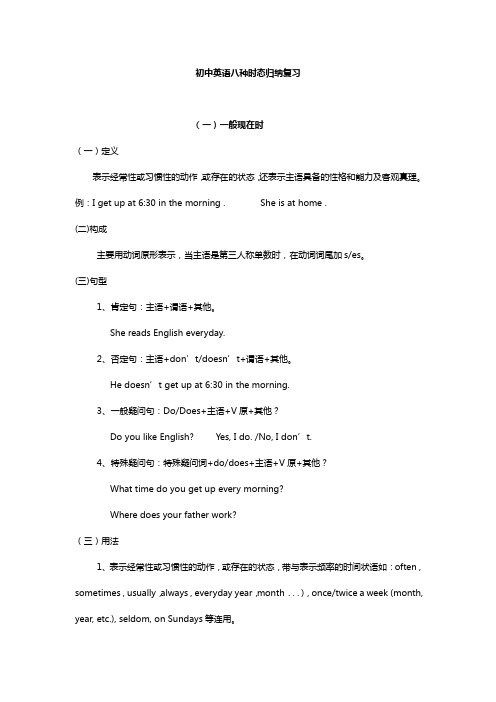
初中英语八种时态归纳复习(一)一般现在时(一)定义表示经常性或习惯性的动作,或存在的状态,还表示主语具备的性格和能力及客观真理。
例:I get up at 6:30 in the morning . She is at home .(二)构成主要用动词原形表示,当主语是第三人称单数时,在动词词尾加s/es。
(三)句型1、肯定句:主语+谓语+其他。
She reads English everyday.2、否定句:主语+don’t/doesn’t+谓语+其他。
He doesn’t get up at 6:30 in the morning.3、一般疑问句:Do/Does+主语+V原+其他?Do you like English? Yes, I do. /No, I don’t.4、特殊疑问句:特殊疑问词+do/does+主语+V原+其他?What time do you get up every morning?Where does your father work?(三)用法1、表示经常性或习惯性的动作,或存在的状态,带与表示频率的时间状语如:often , sometimes , usually,always , everyday year,month...), once/twice a week (month, year, etc.), seldom, on Sundays等连用。
I leave home for school at seven every morning.2、表示客观真理,科学事实、格言警句。
The sun rises in the east .日出东方。
The earth goes around the sun .地球绕着太阳转。
Ten minus two is eight.十减二等于八。
Light travels faster than sound .光的速度比声音的速度快。
(完整版)初中英语八种基本时态总结
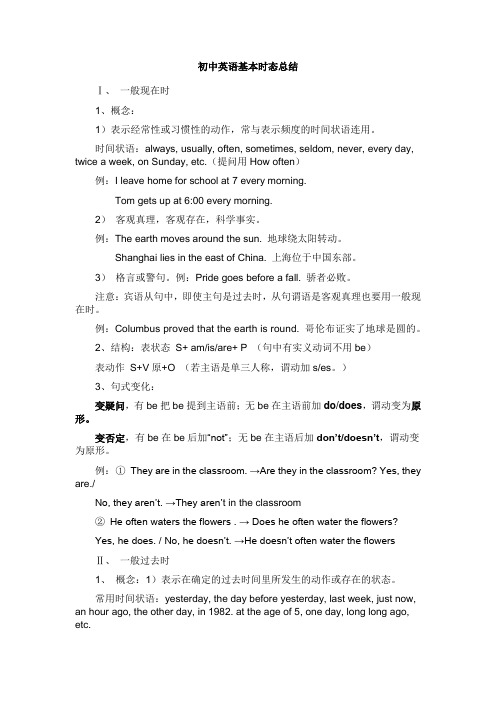
初中英语基本时态总结Ⅰ、一般现在时1、概念:1)表示经常性或习惯性的动作,常与表示频度的时间状语连用。
时间状语:always, usually, often, sometimes, seldom, never, every day, twice a week, on Sunday, etc.(提问用How often)例:I leave home for school at 7 every morning.Tom gets up at 6:00 every morning.2)客观真理,客观存在,科学事实。
例:The earth moves around the sun. 地球绕太阳转动。
Shanghai lies in the east of China. 上海位于中国东部。
3)格言或警句。
例:Pride goes before a fall. 骄者必败。
注意:宾语从句中,即使主句是过去时,从句谓语是客观真理也要用一般现在时。
例:Columbus proved that the earth is round. 哥伦布证实了地球是圆的。
2、结构:表状态S+ am/is/are+ P (句中有实义动词不用be)表动作S+V原+O (若主语是单三人称,谓动加s/es。
)3、句式变化:变疑问,有be把be提到主语前;无be在主语前加do/does,谓动变为原形。
变否定,有be在be后加“not”;无be在主语后加don’t/doesn’t,谓动变为原形。
例:①They are in the classroom. →Are they in the classroom? Yes, they are./No, they aren’t. →They aren’t in the classroom②He often waters the flowers . → Does he often water the flowers?Yes, he does. / No, he doesn’t. →He doesn’t often water the flowersⅡ、一般过去时1、概念:1)表示在确定的过去时间里所发生的动作或存在的状态。
初中英语八种时态归纳复习

初中英语⼋种时态归纳复习初中英语⼋种时态归纳复习⼀、⼀般现在时:班级:姓名:概念:经常、反复发⽣的动作或⾏为及现在的某种状况。
时间状语:always, usually, often, sometimes, every week(day,year,month…), once a week, on Sundays, etc.基本结构:①be动词——am/is/are;例如:He is a student.②⾏为动词——原形或第三⼈称单数。
例如:I usually get up at 6.He watches TV twice a week.否定形式:①am/is/are+not; 例如:He isn’t a student.②谓语动词若为⾏为动词原形,则在其前加don't。
I don’t usually get up at 6.若动词为第三⼈称单数,则在其前加doesn't,同时还原⾏为动词。
例如:He doesn’t watch TV twice a week.⼀般疑问句:①把be动词放于句⾸;例如:Is he a student?②谓语动词若为⾏为动词原形⽤助动词do提问,例如:Do you usually get up at 6?若主语为第三⼈称单数,则⽤does,同时还原⾏为动词。
例如:Does he watch TV twice a week?⼆、⼀般过去时:概念:过去某个时间⾥发⽣的动作或状态;过去习惯性、经常性的动作、⾏为。
时间状语:ago, yesterday, last week(year,night,month…), in 1989, just now, at the age of 5, etc.基本结构:①be动词——was/were;例如:I was late yesterday.②⾏为动词——过去式。
例如:I went home at nine o'clock yesterday.否定形式:①was/were+not; I wasn’t late yesterday.②在⾏为动词前加didn't,同时还原⾏为动词。
初中英语八种时态归纳复习
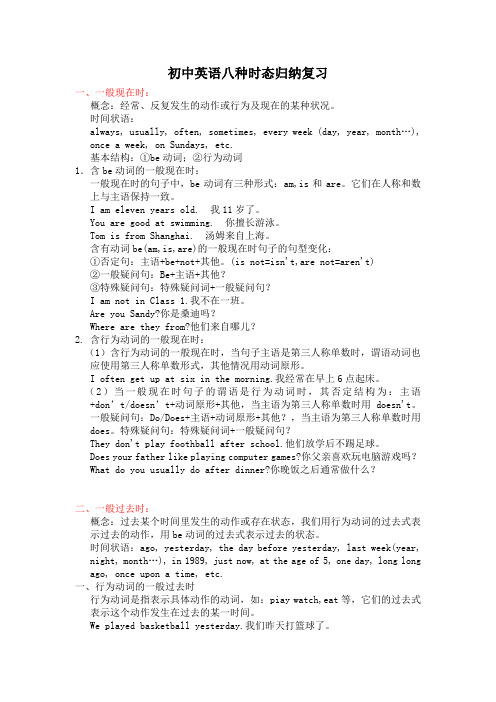
初中英语八种时态归纳复习一、一般现在时:概念:经常、反复发生的动作或行为及现在的某种状况。
时间状语:always, usually, often, sometimes, every week (day, year, month…), once a week, on Sundays, etc.基本结构:①be动词;②行为动词1.含be动词的一般现在时:一般现在时的句子中,be动词有三种形式:am,is和are。
它们在人称和数上与主语保持一致。
I am eleven years old. 我11岁了。
You are good at swimming. 你擅长游泳。
Tom is from Shanghai. 汤姆来自上海。
含有动词be(am,is,are)的一般现在时句子的句型变化:①否定句:主语+be+not+其他。
(is not=isn't,are not=aren't)②一般疑问句:Be+主语+其他?③特殊疑问句:特殊疑问词+一般疑问句?I am not in Class 1.我不在一班。
Are you Sandy?你是桑迪吗?Where are they from?他们来自哪儿?2. 含行为动词的一般现在时:(1)含行为动词的一般现在时,当句子主语是第三人称单数时,谓语动词也应使用第三人称单数形式,其他情况用动词原形。
I often get up at six in the morning.我经常在早上6点起床。
(2)当一般现在时句子的谓语是行为动词时,其否定结构为:主语+d on’t/doesn’t+动词原形+其他,当主语为第三人称单数时用doesn't。
一般疑问句:Do/Does+主语+动词原形+其他?,当主语为第三人称单数时用does。
特殊疑问句:特殊疑问词+一般疑问句?They don't play foothball after school.他们放学后不踢足球。
- 1、下载文档前请自行甄别文档内容的完整性,平台不提供额外的编辑、内容补充、找答案等附加服务。
- 2、"仅部分预览"的文档,不可在线预览部分如存在完整性等问题,可反馈申请退款(可完整预览的文档不适用该条件!)。
- 3、如文档侵犯您的权益,请联系客服反馈,我们会尽快为您处理(人工客服工作时间:9:00-18:30)。
初中英语八种时态归纳复习时态是英语学习中一个至关重要的内容,广大初中学生在实际运用时,往往对时态问题倍感棘手,下面我们就归纳复习一下这几种时态。
一、一般现在时(一)定义表示经常性或习惯性的动作,或存在的状态,还表示主语具备的性格和能力及客观真理。
例:I get up at 6:30 in the morning .She is at home .(二)构成主要用动词原形表示,当主语是第三人称单数时,在动词词尾加s/es。
(三)句型1、肯定句:主语+谓语+其他。
She reads English everyday .2、否定句:主语+don’t/doesn’t+谓语+其他。
He doesn’t get up at 6:30 in the morning .3、一般疑问句:Do/Does+主语+V原+其他?Do you like English ? Yes ,I do ./No, I don’t .4、特殊疑问句:特殊疑问词+do/does+主语+V原+其他?What time do you get up every morning ?Where does your father work ?(三)用法1、表示经常性或习惯性的动作,或存在的状态,带与表示频率的时间状语如:often , sometimes , usually,always , everyday year,month...) , once/twice a week (month , year , etc.) , seldom , on sundays等连用。
I leave home for school at seven every morning .2、表示客观真理,科学事实、格言警句。
The sun rises in the east .日出东方。
The earth goes around the sun .地球绕着太阳转。
Ten minus two is eight.十减二等于八。
Light travels faster than sound .光的速度比声音的速度快。
The United States lies by the west coast of the Pacific Ocean. 美国位于太平洋西岸。
3、根据英文语法规定,当主句的谓语动词是一般将来时,那么时间或条件状语从句的谓语动词只能用一般现在时来表示将来要发生的动作。
I'll tell him the news when he comes back. 他回来时,我将告诉他这个消息。
If you come this afternoon,we’ll have a meeting .4、仅为了描述状态、性质、特征、能力等等。
这里的目的是为了"描述现阶段的动作或状态",其重点"不是强调动作发生的时间、或进行的状态"。
例如:He can speak five foreign languages .他能说五种外语。
That is a beautiful city .那是座美丽的城市。
Changjiang River is one of the longest rivers in the world. 长江是世界上最长的河流之一。
She majors in music .她主修音乐。
All my family love football .我全家人都喜欢足球。
My sister is always ready to help others . 我妹妹总是乐于助人。
(四)动词第三人称单数形式变化规则1、一般情况下,动词后直接加-s;如:help-helps ,clean-cleans ,give-gives等。
2、以s,x,ch,sh或o结尾的动词,在词尾加-es;如:dress-dresses,fix-fixes,watch-watches,finish-finishes等。
3、以辅音字母加y结尾的动词,把y变为i,再加-es;如:study--studies,fly-flies,carry--carries等。
4、动词have遇在主语是第三人称单数时,have改为has,如:He has an interesting book .5、动词be遇有主语是第一人称单数时,be改为am,遇有主语是第二人称时,be改为are,遇有主语是第三人称单数时,be改为is一般现在时练习题1)用动词的适当形式填空1.I like ____________ (swim).2.He _________(read) English every day.3.We _________(go)to school at seven in the morning.4.Mike________(go)to school at seven in the morning.5.My mother________(like) ______(go) shopping.6.I can ________(draw) many beautiful pictures.7.She_________(make) a model plane.8.Do you ________(like)_________(run)?9.Does he_________(like)_________(jump) ?10.Does Nancy_________(grow)flowers on Saturday ?11.The teachers________(like)___________(dance).12.The teacher________(like)____________(dance).13.The students___________(speak) English in class.14.The student_________(speak) Chinese after class.15. Let's____________and play football . ( go )16. He_____________ like swimming . ( not )17. I'm sorry ____________that . ( hear )18. Wang Bing is____________ ( write ) an E-mail to his friend .19. He has_____________a headache . ( get )20. _________you study English at school ? Yes , I___________. ( do )21. __________your sister study English at school ? No , she__________ . ( do )22. I'm _________ better . ( feel )23. Why__________Tom absent today ? ( be )2)用所给的人称改写句子1.I take photos on Sunday. ( Mike)2.We grow beautiful flowers. (she)3.They like collecting stamps. (Ben)4.I listen to music carefully. (my aunt)5.You like making a model ship. (Helen)6.We clean the classroom every day. (he)7.They look after the pandas. (Mr Wang)8.I draw a tree and some flowers. (Nancy)9.We go to bed at eight. ( my sister)10.I read newspapers in the evening. (Mr Green)3)写出下列动词的相应形式1. 第三人称单数:wash_________ match _______guess______ study______ finish_________go________ snow______ carry_________2.写出下列动词的过去式:stop______ see________ drive ________let_______ carry______ keep_____ join______ find_______ think________ teach______ catch______3. 写出下列动词的现在分词形式:stay_______ begin______ forget_______ forget______lie________ die _______ run_______ prefer______ give________ ring_______ dance______ hope_______II. 用所给动词的适当形式填空:1.I ________(write) to you as soon as I _______(get) to London.2. He doean't feel well and ____________(not eat) any food this morning.3. He ______ not _______(see) me come in, for he ___________(read) something with great interest.4. I _________(l;et) you have the book as soon as I _________(finish) it.5. While we ________(wait) for our teacher, a little boy ________(run) up to us.6. Don't make a niose. Grandpa __________(sleep).7.It's seven now, Tom'sfamily__________(watch) TV.8. It ________(take) me two hours to finish my homework last night.9. What ______ your mother _______(do) at eight yesterday evening? She _______(wash) clothes.10. _______ it ______ (rain) when school was over yesterday?11. What _______(do) _______ tomorrow? We ________ (play) football.12. There ________ (be) a football match on TV this evening.13. They said they ________ (visit) the Great Wall the next summer holiday.14. Who _______ (dance) the best in your class? 15. Will you come if he _____________ (not come)?16. The teacher told us the earth __________ (move) round the sun. 17She ________ (buy) a sweater yesterday.18. They _______ (have) a party in the garden if it ________ (not rain) tomorrow.19. I don't know if Mr.Wang ______ (go) to Shanghai tomorrow. If he _____ (go), I ______ (ask) him _______ (take) some books to my daughter, because she _______ (study) there.III单项选择:1.The students will go to the Summer Palace if it _____ tomorrow. A.don't rain B. doesn't rain C. won't rain2. There _____ an English film next week. A. will have B. is going to have C. is going to be D. was going to be3. The picture _______ nice. A.looks B.is looked C.look D.is looking4. She ______ down and soon fell asleep. A. live B. lain C. laid D. lay5. They _____ the office at nine yesterday morning. A. reached to B. arrived C. went D. get to6. We shall go to Shanghai on business before you _____ back next week.A. wil comeB. cameC. would comeD. come7. Don't smoke until the plane ______ off. A.takes B.took C.was taken D.is take8. I saw her ____ the room this morning. A.to enter B. entered C. enter D. enters9.the teacher asked us ______ to school on time. A. to come ing e es10. John is always ______ others. A. help B. helping C. helps D. to help11. He told us ______ at eight. A. working B. to work C. work D. worked12. You'd better ______ at home and ______ your homework.A. to stay, doB. stay, doC. to stay, to doD. stay, to do13. He sat down ______ a rest. A. having B. have C. to have D. had14. Uncle Wang knows _______ a washing machine.A. how to makeB. to makeC. how makingD. what to make15. Jim decided _______ Polly to Ling Feng when he was back to England.A. to leaveB. leftC. leavingD. leave二、一般过去时(一)结构一般过去时用动词的过去式表示。
